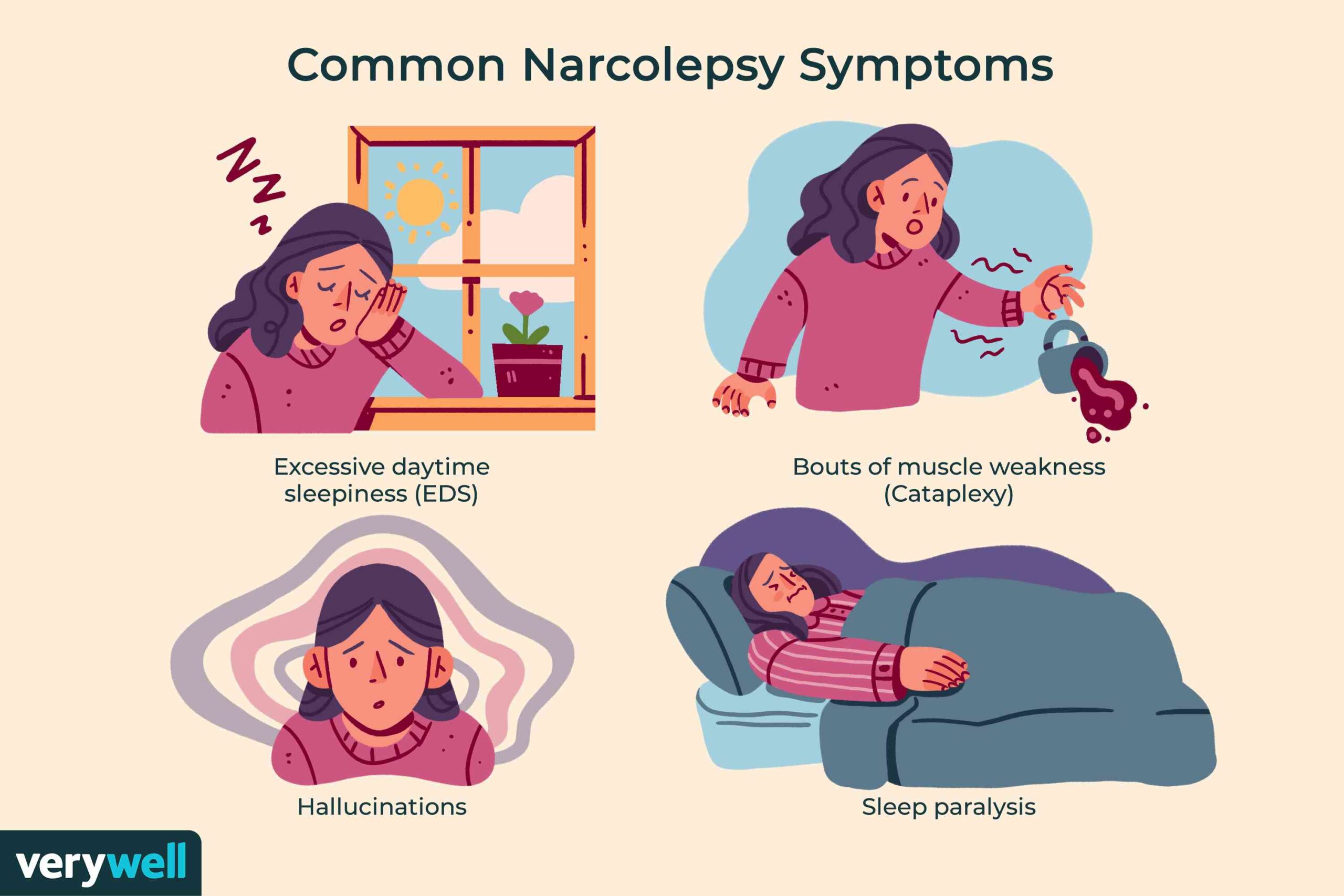Deafness Sensorineural-various aspects-
Deafness Sensorineural
Damage to inner ear tissues or the auditory nerve results in Deafness Sensorineural -sensorineural hearing loss (SNHL). More than 90% of adult hearing loss is caused by it. Loud noise exposure, genetics, or the normal ageing process are common causes of SNHL.
Your cochlea, an organ that spirals inside your inner ear, is home to microscopic hairs called stereocilia. Your auditory nerve sends neural signals to your brain through these hairs, which then transform sound wave vibrations into neural signals. exposure to noise above 85 decibels .
However, it’s possible that you won’t notice hearing loss until 30 to 50 percent of these hairs are damaged. From inside a car, 85 dB is similar to loud traffic noise.
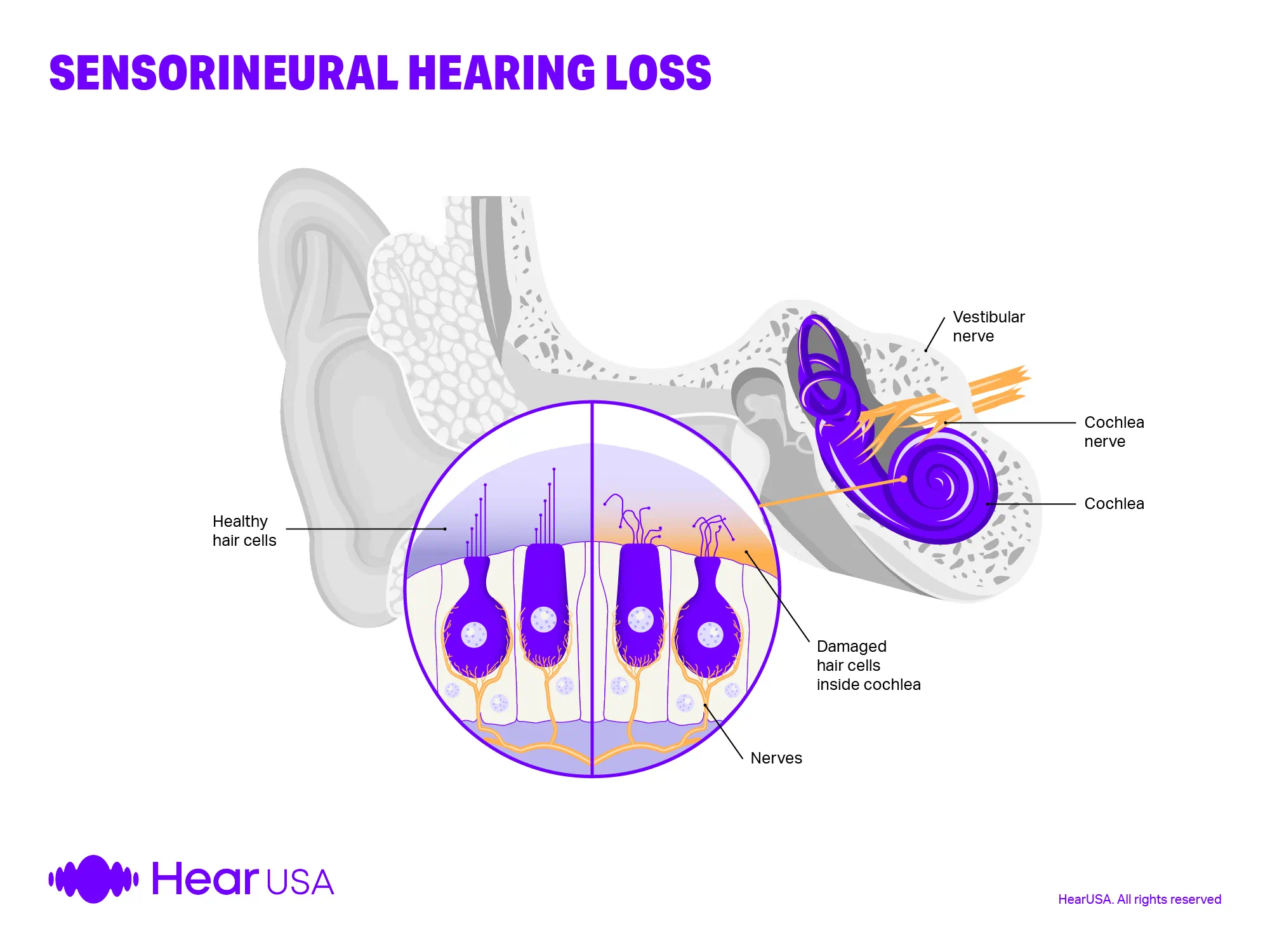
Depending on the extent of the damage, deafness sensorineural (SNHL) can range from minor hearing loss to total loss of hearing.
- a slight hearing loss. an audible loss of 26 to 40 dB.
- a slight hearing loss. a hearing loss of between 41 and 55 dB.
- profound hearing loss. a hearing loss that is louder than 71 dB.
Although SNHL is not a life-threatening condition, if it is not treated properly, it can affect your ability to communicate. To learn what causes SNHL-deafness sensorineural -how to prevent it, and your treatment choices if you already have it, continue reading.
Any patient with sensorineural hearing loss may contact ENT specialist doctor Dr Sagar Rajkuwar (MS-ENT) for online consultation or actual consultation in clinic at the following address-
Prabha ENT(Ear, Nose, Throat) clinic, Dr Sagar Rajkuwar( MS-ENT) is open for patient consultation from 11 am to 6 pm. -Address -Prabha ENT clinic, plot no 345 ,Saigram colony ,opposite Indoline furniture, Ambad link road ,Ambad , 1 km from Pathardi phata ,Nashik ,422010 ,Maharashtra ,India .
Cell no- 7387590194 , 9892596635
Issued in public interest by –
Signs of sensorineural hearing loss
Depending on the aetiology, SNHL may affect one or both ears. Without a hearing test, your symptoms might not be apparent if your SNHL develops gradually. The symptoms of abrupt SNHL will appear over the course of a few days. Many people wake up for the first time, noticing sudden SNHL.
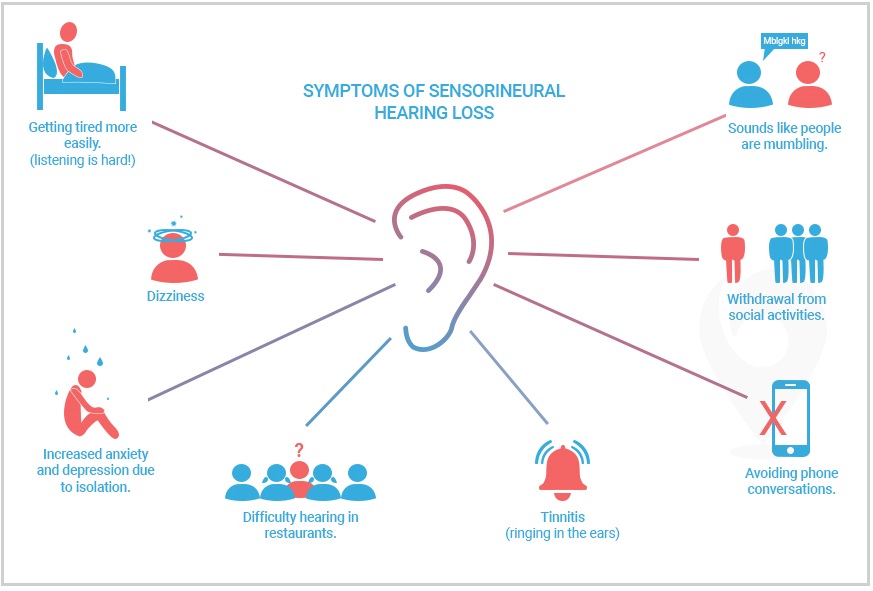

Following a sensorineural hearing loss,
- trouble hearing noises in noisy environments, especially female and child voices.
- unsteadiness or balance issues
- difficulty hearing loud noises
You have the impression that noises and conversations are muffled and that you can hear but not understand them.
(ringing in the ears) Tinnitus
Causes of sensorineural hearing loss-deafness sensorineural
SNHL can be acquired or congenital, which means that it is present at birth. The following are possible SNHL causes:
Congenital Congenital hearing loss is one of the most prevalent birth defects and is present at birth. Per 1,000 births, 1 to 3 babies are affected by it. Reliable Source.
Children with congenital hearing loss develop it for genetic reasons about half of the time and the other half for environmental factors, according to reliable sources. Genetic hearing loss has been linked to more than 100 genes. Hearing loss can be brought on by infections as well as a lack of oxygen.
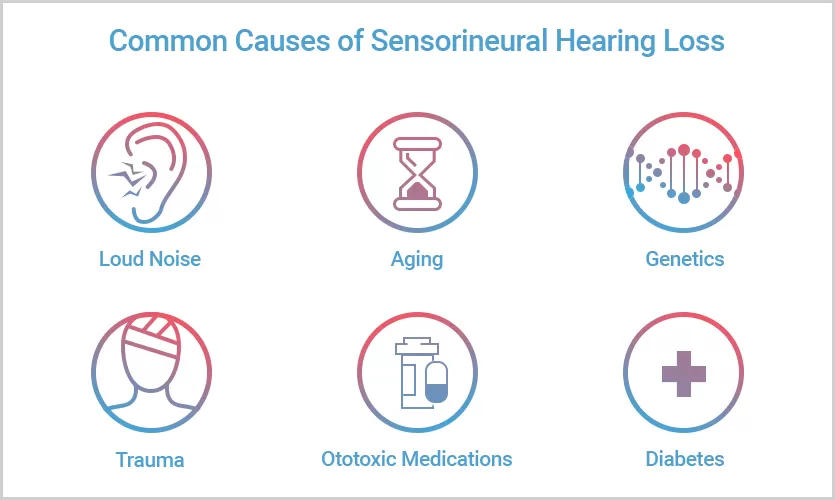

Loud sounds
SNHL-deafness sensorineural may result from exposure to sounds louder than 85 dB. Even a single encounter with loud noises like gunshots or explosions can permanently harm one’s hearing.
Presbycusis
Another name for hearing loss caused by ageing is presbycusis. In the United States, between the ages of 65 and 74, approximately one in three adults experiences hearing loss. About half of people over the age of 75 have some form of hearing loss.
Hearing loss caused by conductive vs. sensorineural hearing loss-deafness sensorineural
SNHL may result from harm to the inner ear structures or the auditory nerve. Problems translating sound vibrations into neural signals that the brain can understand result from this form of hearing loss.
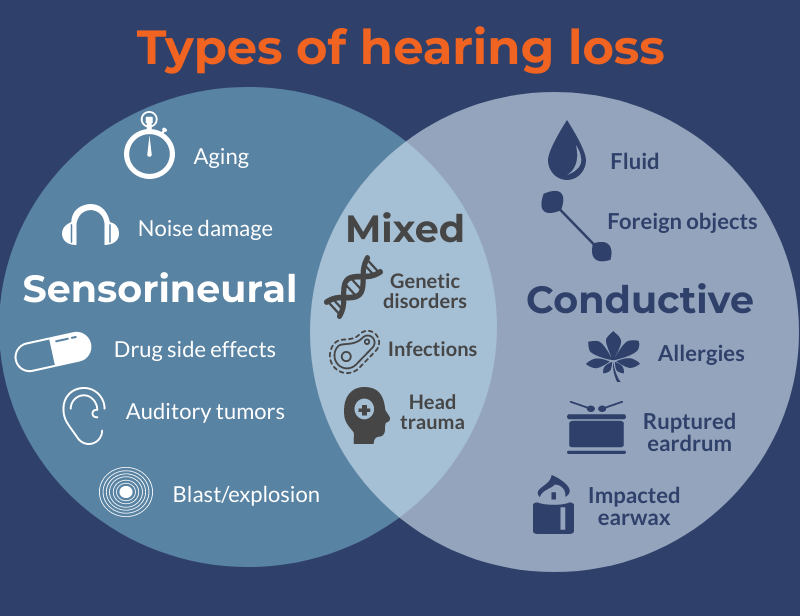

When sound cannot flow through your outer or middle ear, conductive hearing loss results. Conduction hearing loss can be brought on by the following:
- liquid accumulation in ear infections
- You have an eardrum hole.
- harmless tumours
- blockage of earwax by foreign things
- distortions in the middle or outer ear
Similar symptoms can be brought on by either type of hearing loss. However, conductive hearing loss frequently results in muffled sound perception, whereas SNHL-deafness sensorineural results in muffled and distorted sound perception.
A few people have a combination of conductive and sensorineural hearing loss. If there are issues both before and after the cochlea, the hearing loss is deemed mixed.
If you have hearing loss, it’s crucial to receive a professional diagnosis. You might be able to regain your hearing in some circumstances. Your chances of minimising harm to the ear’s structures increase with the speed of your treatment.
Loss of hearing sensation suddenly (SSHL)


A hearing loss of at least 30 decibels within 3 days is referred to as SSHL. 5 to 20 people out of every 100,000 are affected. dependable source; typically, it only impacts one ear. Deafness caused by SSHL can happen quickly or gradually over a few days. Many people only notice it after waking up in the morning, and it frequently only affects one ear.
MEDICAL ERRATIC
There could be a major underlying cause of SSHL. See a doctor as soon as you can if you suddenly lose your hearing.
Sudden deafness can result from any of the following reasons:
- infections
- head injury
- Autoimmune condition
- Meniere’s illness
- certain medications or drugs
- circulatory issues
The recommendation of corticosteroids is the most typical form of treatment for unexpected hearing loss. You have the best chance of hearing again if you start taking corticosteroids within two weeks of the commencement of SSHL.
Sensorineural hearing loss-deafness sensorineural -types
Depending on the source, sensorineural hearing loss can damage either one or both ears.
Sensorineural hearing loss-deafness sensorineural -on both sides. SNHL in both ears can be caused by genetics, loud noise exposure, and conditions like the measles.
sensorineural hearing loss that is unilateral. If SNHL is brought on by a tumour, Meniere’s disease, or a sudden loud noise in one ear, it may only affect that ear.
sensorineural hearing loss with asymmetries When there is hearing loss on both sides but one side is worse than the other, this condition is known as asymmetrical SNHL.
For update on further important health related topics and frequently asked questions on health topics by general population please click on the link given below to join our WhatsApp group –
https://chat.whatsapp.com/Lv3NbcguOBS5ow6X9DpMMA
Issued in public interest by –
Diagnosis of sensorineural hearing loss
In order to accurately identify sensorineural hearing loss, doctors use a variety of tests.
Examination of the body
A physical examination can help distinguish between conductive hearing loss and SNHL- deafness sensorineural -A doctor will check for swelling, fluid or earwax buildup, eardrum damage, and foreign objects.
Tuning knuckles
A tuning fork test could be used by a doctor as a preliminary examination. Particular tests consist of:
The Weber test.
The medical professional lightly taps a 512-Hz tuning fork against the middle of your forehead. Hearing loss is probably conductive if the affected ear is louder than the other ears. The unaffected ear should be louder than the affected ear if you have sensorineural hearing loss.
Test Rinne.
When you are no longer able to hear the sound, the doctor strikes a tuning fork against your mastoid bone behind your ear. When you are unable to hear the sound, the doctor slides the tuning fork away from your ear canal. If you have SNHL-deafness sensorineural the tuning fork will sound clearer in front of your ear canal than it will against your bone.
Audiogram
A doctor would probably refer you to an audiologist for a more thorough audiometer test if they suspect you have hearing loss.
You’ll use headphones while taking the test in a soundproof booth. Each ear will get sounds and phrases played at a distinct pitch and volume. The test assists in identifying the softest sound you can hear as well as particular frequencies of hearing loss.
SNHL -deafness sensorineural therapy
There isn’t yet a surgical option to treat SNHL. To help you make up for hearing loss, hearing aids and cochlear implants are the most popular solutions. The field of research into gene therapy for hearing loss is developing. SNHL is not currently being treated therapeutically with it, though.
Audio devices
Specific hearing loss symptoms can be matched by modern hearing aids. A hearing aid, for instance, can help you focus on high-frequency noises without influencing other frequencies if you have trouble hearing them.
Implanted cochlea
To help with severe SNHL-deafness sensorineural -a cochlear implant can be surgically implanted. A cochlear implant consists of two components: a microphone worn behind the ear and a receiver placed inside the ear that communicates electrical signals to the auditory nerve.
Prognosis for sensorineural hearing loss
Depending on the severity and source of hearing loss, the future for those with SNHL varies greatly. The most typical form of persistent hearing loss is SNHL.
According to the Hearing Loss Association of America, 85% of patients with abrupt SSHL-deafness sensorineural -will make at least a partial recovery if they receive treatment from an ear, nose, and throat doctor. Within two weeks, between 32 and 65 percent of people spontaneously regain their hearing.
Is there an increase in sensorineural hearing loss?
If SNHL is brought on by aging-related or genetic factors, it frequently worsens over time. If you prevent the source of the hearing damage, whether it’s a sudden loud noise or environmental variables, symptoms will probably plateau.
Takeaway-deafness sensorineural –
For many people, SNHL is a normal component of ageing. But exposure to loud noises can also permanently harm your auditory nerve or inner ear. You can prevent noise-related ear damage by adopting the following good hearing habits:
- Reduce the volume of your headphones to under 60%.
- When around loud noises, wear earplugs.
- Before beginning a new medicine, seek medical advice.
- Regularly test your hearing.
Any patient with sensorineural hearing loss may contact ENT specialist doctor Dr Sagar Rajkuwar (MS-ENT) for online consultation or actual consultation in clinic at the following address-
Prabha ENT(Ear, Nose, Throat) clinic, Dr Sagar Rajkuwar( MS-ENT) is open for patient consultation from 11 am to 6 pm. -Address -Prabha ENT clinic, plot no 345 ,Saigram colony ,opposite Indoline furniture, Ambad link road ,Ambad , 1 km from Pathardi phata ,Nashik ,422010 ,Maharashtra ,India .
For appointment -Contact no-7387590194 , 9892596635 . Surgeries done in attached hospitals : Mastoid -ear surgery, Functional endoscopic sinus surgery, Stichless Endoscopic ear surgeries like Ossciculoplasty and Tympanoplasty ,Endoscopic Septoplasty, Tonsillectomy and Adenoidectomy Surgery. Also advice available for Hearing aids and various Ear, Nose, Throat problems.
Issued in public interest by –



